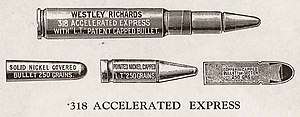.318 Westley Richards
The .318 Westley Richards, also known as the .318 Rimless Nitro Express and the .318 Accelerated Express, is a proprietary medium bore centerfire rifle cartridge developed by Westley Richards.
| .318 Westley Richards | ||||||||||||
|---|---|---|---|---|---|---|---|---|---|---|---|---|
 Illustration from the 1938-39 Westley Richards brochure | ||||||||||||
| Type | Rifle | |||||||||||
| Place of origin | England | |||||||||||
| Production history | ||||||||||||
| Designer | Westley Richards | |||||||||||
| Designed | 1906 | |||||||||||
| Produced | 1906 | |||||||||||
| Specifications | ||||||||||||
| Case type | Rimless, bottleneck | |||||||||||
| Bullet diameter | .330 in (8.4 mm) | |||||||||||
| Neck diameter | .358 in (9.1 mm) | |||||||||||
| Shoulder diameter | .436 in (11.1 mm) | |||||||||||
| Base diameter | .464 in (11.8 mm) | |||||||||||
| Rim diameter | .464 in (11.8 mm) | |||||||||||
| Case length | 2.368 in (60.1 mm) | |||||||||||
| Overall length | 3.349 in (85.1 mm) | |||||||||||
| Case capacity | 69.1 gr H2O (4.48 cm3) | |||||||||||
| Ballistic performance | ||||||||||||
| ||||||||||||
| Test barrel length: 28 in Source(s): The Spanish Association of Cartridge Collectors[1] & Kynoch.[2] | ||||||||||||
Design
Westley Richards introduced the .318, primarily for use in their M98 Mauser and later their P14 Enfield based bolt action sporting rifles.
The .318 Westley Richards is a rimless bottlenecked cartridge primarily intended for use in Africa. The bullet diameter is actually .330", the naming is due to British nomenclature which sometimes names cartridges by their land diameter rather than the more commonly applied groove diameter.[3]
Westley Richards offered solid, soft-point or the revolutionary LT-capped[note 1] bullets in two loadings, the more common being a 250 gr (16 g) bullet with a listed speed of 2,400 ft/s (730 m/s), whilst a lighter loading firing a 180 gr (12 g) bullet at 2,700 ft/s (820 m/s) was also offered for lighter game.[5] The 250gr bullet possessed high sectional density and thus excellent penetration.[3]
History
Most sources state the .318 Westley Richards was introduced in 1910, although a Westley Richards catalogue contains a testimonial from a satisfied customer dated March 1909 who used his rifle to take 10 elephants, indicating the cartridge must have been introduced by at least 1908. Upon the introduction of the .318 Westley Richards, Westley Richards effectively stopped marketing their .375/303 Westley Richards Accelerated Express.[3][6]
The .318 Westley Richards was one of the most popular medium-bore cartridges used in Africa, even after the introduction of the .375 Holland & Holland.[5] As with many British proprietary cartridges, the .318 Westley Richards was forced into obsolescence when Kynoch suspended ammunition manufacturing in the 1960s. Kynamco resumed manufacture of the Kynoch range of cartridges in the 1990s meaning the ammunition is again commercially available, although no firearms manufacturers make factory rifles in .318 Westley Richards today.
Use
While the cartridge is not intended for dangerous game, it has been used successfully on all African game species up to and including elephant. The cartridge was a contemporary of and very similar in performance to the .333 Jeffery, both were somewhat overshadowed by the arrival of the .375 Holland & Holland.[7]
In his African Rifles and Cartridges, John "Pondoro" Taylor wrote that the 250gr .318 Westley Richards is "fully capable of driving its bullet the full length of a big elephant's body."[8]
W.D.M. "Karamojo" Bell wrote that the .318 Westley Richards was a more reliable killer for certain shots than his favoured .275 Rigby, but the .275 Rigby was a "surgeons" rifle.[9] On one occasion Bell used a pair of .318 Westley Richards rifles to take nine elephants with nine shots, he later wrote "In my opinion, the 250gr .318, although far from perfect, approaches most nearly the big game hunter's ideal bullet".[3]
James H. Sutherland, who over the course of his life shot between 1,300 and 1,600 elephants, used a .318 Westley Richards along with a .577 Nitro Express double rifle for all his African hunting, in a letter to Westley Richards he wrote "In open country, against Elephants and Rhinoceroses where the quarry is difficult to approach and long shots are often required I find that I can do all that is requisite with the .318 using of course, solid nickel covered bullets."[10]
Other users of the .318 Westley Richards include Major G.H. Anderson who shot between 350 and 400 elephants; and Quentin Grogan who shot between 250 and 300 elephants.[10]
Notes
- The LT-capped bullet was named after Leslie B Taylor (1863-1930) an engineer and lifelong employee at Westley Richards who, among many inventions, designs and patents, invented the ‘Capped Bullet’, a revolutionary bullet design that allowed for both maximum shock effect whilst ensuring maximum stability and accuracy.[4]
See also
References
- The Spanish Association of Cartridge Collectors, "318 Westley", www.municion.org, archived, 01 January 2015.
- Kynoch Ammunition, "Big Game Cartridges", www.kynochammunition.co.uk, archived, 15 August 2016.
- Gregor Woods, “Think Thirty-Three Calibre”, ezine.nitroexpress.info, retrieved 21 November 2016.
- Trigger, "Leslie B Taylor 'Capped Bullet' ", thexplora.com, retrieved 19 April 2017.
- Frank C. Barnes, Cartridges of the World, ed 13, Gun Digest Books, Iola, 2012, ISBN 9781440230592.
- Don Davie, "The other .303 cartridges", acant.org.au, retrieved 25 January 2015.
- Paul Roberts, “Nitro big game rifles”, ezine.nitroexpress.info, retrieved 13 November 2015.
- John Taylor, African rifles and cartridges, Sportsman’s Vintage Press, 2013, ISBN 978-1-940001-01-2.
- James Passmore, "W.D.M. Bell and His Elephants", www.chuckhawks.com, retrieved 21 November 2016.
- Simon Clode, "Famous hunters and their Westley Richards rifles", theexplora.com, retrieved 21 November 2016.
External links
- Ammo-One, ".318 Rimless Nitro Express", ammo-one.com, retrieved 11 August 2017.
- Cartridgecollector, ".318 Westley Richards", cartridgecollector.net, retrieved 16 December 2016.
- Charlie Haley, ".318 Westley Richards", africahunting.com, retrieved 21 November 2016.